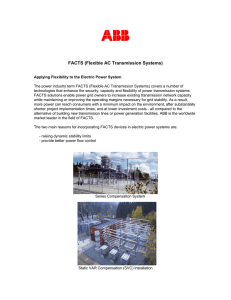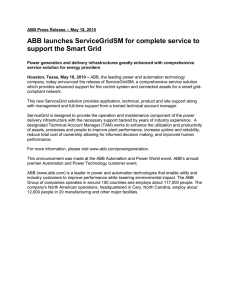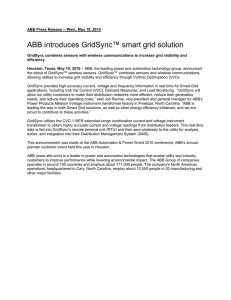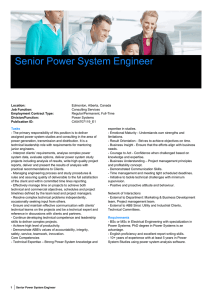ABB - NTNU
advertisement
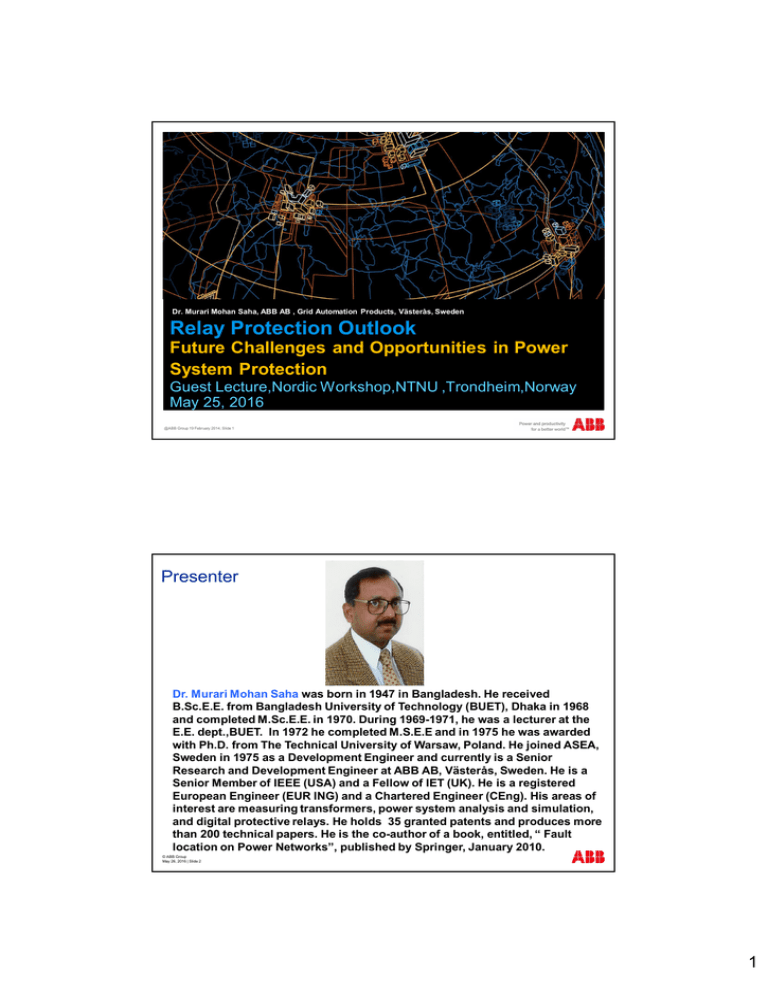
Dr. Murari Mohan Saha, ABB AB , Grid Automation Products, Västerås, Sweden Relay Protection Outlook Future Challenges and Opportunities in Power System Protection Guest Lecture,Nordic Workshop,NTNU ,Trondheim,Norway May 25, 2016 @ABB Group 19 February 2014, Slide 1 Presenter Dr. Murari Mohan Saha was born in 1947 in Bangladesh. He received B.Sc.E.E. from Bangladesh University of Technology (BUET), Dhaka in 1968 and completed M.Sc.E.E. in 1970. During 1969-1971, he was a lecturer at the E.E. dept.,BUET. In 1972 he completed M.S.E.E and in 1975 he was awarded with Ph.D. from The Technical University of Warsaw, Poland. He joined ASEA, Sweden in 1975 as a Development Engineer and currently is a Senior Research and Development Engineer at ABB AB, Västerås, Sweden. He is a Senior Member of IEEE (USA) and a Fellow of IET (UK). He is a registered European Engineer (EUR ING) and a Chartered Engineer (CEng). His areas of interest are measuring transformers, power system analysis and simulation, and digital protective relays. He holds 35 granted patents and produces more than 200 technical papers. He is the co-author of a book, entitled, “ Fault location on Power Networks”, published by Springer, January 2010. © ABB Group May 26, 2016 | Slide 2 1 Contents § ABB AB , Grid Automation Products § Smart Grids for Protections – Benefits and Challenges § Protections for Smart Grids § Development trends § Innovations based on abundant information § Future Challenges and Opportunities § Digital Substation – Introduction § Cyber Security § Summary © ABB Group 26 maj 2016 | Slide3 Grid Automation Products Västerås § Global responsibility for protection and control products for generation, transmission and sub-transmission § Annual sales ~ 130 MUSD § Export § § 95 % of the production § To more than 90 countries Employees § Approximately 210 © ABB Group April 2011 2 Grid Automation Products worldwide Factories and sales centers Västerås . Istanbul Raleigh Shanghai Dubai Bangalore Kuala Lumpur Sao Paulo Johannesburg Global Focused Factory Lead Center Regional Focused Factory Regional Sales Center © ABB Group Slide 5 Grid Automation Products Products from bay level to SCADA/DMS applications Network control and distribution management Control and automation at station level Protection and control IEDs © ABB Group Slide 6 3 Smart Grid @ABB Group 19 February 2014, Slide 40 When grids aren’t so smart?! 4 The environment Global challenges are driving change @ABB Group 19 February 2014, Slide 4 Worldwide drivers for a different type of electricity supply § Growth § Population § § Economy – in particular in emerging countries Sustainability § § § Pollution – locally Climate change – globally Limitation of resources § Acceptance: difficulties in building infrastructure § Substitution: importance of electricity is still growing, outpacing all other types of energy (IEA) Development of electricity supply and application is the key to more sustainability. @ABB Group 19 February 2014, Slide 5 5 A new generation mix Fundamental changes § Remote generation in big plants § Wind power, in particular offshore § § Distributed generation in small units § § § Hydro power – the Alps, Scandinavia Photovoltaic Combined heat and power generation Volatile generation § Wind power § Solar power Consequences all over the system of power generation, transmission, distribution and consumption. In the end this will require a new system design. @ABB Group 19 February 2014, Slide 9 Dealing with the change Consequences @ABB Group 19 February 2014, Slide 10 6 Strong drivers towards a new type of power systems Consequences Conv. generation Driver Transmission System operation Distribution Application § FACTS Remote, bulk generation § Long § Stabilization dist. transm. § Overlay with FACTS grid/ HVDC § Automation Distributed generation § Voltage regulation § High efficiency all over output range § Flexibility Volatile generation Cost pressure, ageing infrastructure, reliability New loads (E-mobility) § Trans-regional leveling § Overlay § Bulk § Distributed grid/ HVDC storage storage § Automation § Automation § Asset § Asset health management infrastructure 1 cation § Control § VPPs1 § Demand response § VPPs1 § Storage (in applications) § Demand response § Demand health management § Charging @ABB Group 19 February 2014, Slide 11 § Communi- response § Demand response VPP: Virtual Power Plant Renewable energy from volatile sources Consequences for the transmission grids § Dependency on locations: Sources usually far away from centers of load § Volatility and production peaks: Balancing of load and generation becomes more difficult § Conventional power stations as backup Þ reduced contribution of renewable energy § Mixing of different sources § different sources § different regions Þ more long-distance power transmission Both aspects are increasing the need for transmission capacity. @ABB Group 19 February 2014, Slide 12 7 Consequences all over the value chain The way becomes clearer Driver Consequences Strong growth of bulk, remote generation Strong growth of distributed generation Need of long-distance transmission capacity overdue New challenges for distribution networks § Voltage control § Capacity § Protection § Remote supervision, control Strong growth of volatile generation Widely spread consequences § Mix of different sources Þ transmission capacity § Demand response § Storage High generation peaks Bulk storage increasingly relevant now will be required 2015+ will be required 2020+ @ABB Group 19 February 2014, Slide 17 Fundamental changes in power supply Future challenges for electricity supply § Increasing demand § Environmental concerns § Security of supply – less sourcing from sensitive regions More renewable power generation Energy efficiency Distributed and intermittent generation Customer pricing expected to foster demand responses Reliability of supply § Ageing infrastructure § Ageing workforce § IT security Impact on grid stability and efficiency Grids of the future will be different from those of the past § Open for all types and sizes of generation technologies § Integrating demand side in system operation @ABB Group 19 February 2014, Slide 19 8 smart grids traditional grid From traditional to smart grids § Centralized power generation § One-directional power flow § Generation follows load § Top-down operations planning § Operation based on historical experience § Centralized and distributed power generation § Intermittent renewable power generation § Multi-directional power flow § Consumption integrated in system operation § Operation based on real-time data @ABB Group 19 February 2014, Slide 22 Smart Grid Protections play key roles Protections have been key elements in power systems, and will continuously play key roles in smart grids § Safeguard the entire system to maintain continuity of supply § Minimize damage and repair costs where it senses fault § Ensure safety of personnel @ABB Group 19 February 2014, Slide 27 9 Smart Grids for Protections Benefits and Challenges Main Benefits § More Abundant and precise information § Information sharing and integration is much easier, IEC 61850 § More advanced IT technologies, signal processing @ABB Group 19 February 2014, Slide 28 Smart Grids for Protections Benefits and Challenges Technical Challenges § More and more controllable devices, FACTS, HVDC § Centralized and distributed RES / storage, Wind, PV, battery § Higher requirements on the protection performance @ABB Group 19 February 2014, Slide 29 10 Protections for Smart Grids Trends of Development How should protections take advantages of the benefits and meet the challenges? Innovative utilization of abundant information enabled by smart grid § Innovations for better utilization of local bay information § Innovations based on local substation information integration § Innovations based on wide-area information integration @ABB Group 19 February 2014, Slide 30 Wide Area Monitoring Systems Challenges and solutions 1 1 1 4 3 1) Integration of renewables Remote grid operation with distributed generation (wind/solar farms) Increase grid capacity and stability Balance load to supply 4 2 2 4 3 1 Applications and technologies Gateways with bi-directional communication for consumer interaction Smart meters, Internet/mobile telecom, smart houses Customer service systems including billing Fault detection, isolation and restoration; voltage optimization FACTS, HVDC, WAMS à WAMPACS 2) Integration of electric vehicles Charging / billing Energy storage Load management 3) Demand response Real time pricing / tariffs Home automation / load management Distributed generation / storage 4) Reliability and efficiency cyber security customer outage information emergency / peak power @ABB Group 19 February 2014, Slide 33 11 Study on Protection of Large Scale Wind Power Integration © ABB Group 26 maj 2016 | Slide24 Mixed AC-DC GRID © ABB Group 26 maj 2016 | Slide25 12 Impact of HVDC Stations on Protection of AC Systems, CIGRE JWG B5/B4.25,December 2011 q HVDC system may bring about different fault characteristics in the HVAC systems,influence the operation of HVAC protection or even cause mal operation. q When an HVDC scheme is installed, it is recommended that a careful review of protection philosophies and settings in the nearby connected AC networks be made to determine possible adverse affects/risks of mal operation due to the influence of the DC scheme during steady state and transient condition. q However, proper design of protection scheme can prevent mal operation of AC protection. Alternative protection principles need to be considered for some cases. © ABB Group 26 maj 2016 | Slide26 @ABB Group 19 February 2014, Slide 1 13 Change of Electrical Energy System Influence on Protection and Automation § Large distance between Generation and Load Centers § New solutions for energy transport (overlay network, ultra net) § à Protection concepts Reactive power problems (voltage stability) à Supervision via PMUs § Increased Contribution from Renewable Energy in Generation § Increased number of converter stations à Small short circuit currents § Fluctuating generation à Wide range of fault currents § Changed Network Topology § Tapped lines; Sea cables between stations (charging capacitances) à New transient effects § § Combination of overhead lines and short cables à Protection concepts Unpredictable Load Flow due to Fluctuating Generation § Overload problems (setting of protection) à Adaptive protection @ABB Group 19 February 2014, Slide 5 Digital Substation @ABB Group 19 February 2014, Slide 40 14 What is a digital substation? Substation automation protection and control system with IEC 61850 station bus Non-conventional instrument transformers increase safety and reduce footprint Communication system IEC 61850 process bus, connecting the switchyard to the protection and control system Merging units, bridging the gap between analog and digital world. Compliant to IEC 61850 © ABB Group May 26, 2016 | Slide 30 Evolution of substation automation § From wired to optical communication © ABB Group May 26, 2016 | Slide 31 © ABB Group | 15 Evolution of current and voltage transformer § From conventional CTs and VTs to NCITs* Evolution of conventional VTs and CTs Sensors for current and voltage New applications like combined current and voltage NCITs for metering and protection Standardized integration of protection, control and metering with IEC 61850 © ABB Group May 26, 2016 | Slide 32 © ABB Group | *NCITs = non-conventional instrument transformers Digital Substation and IEC61850 Today IEC 61850-8-1 670 series REB500 IEC 61850 Station Bus Replace wiring and legacy protocols between bays by digital communication 650 series Interface to field Hardwired point to point connections between primary and all secondary equipment 16 Digital Substation and IEC61850 Tomorrow IEC 61850-8-1 REB500 670 series 650 series IEC 61850-8-1 IEC 61850-9-2 NCIT NCIT SAM600 SAM600 Digital substation 1) All signals digital, station and process 2) Analog, status and commands 3) Acquire once, distribute on a bus NCIT Non-conventional instrument transformers 17 Cyber Security @ABB Group 19 February 2014, Slide 40 Trend in the Power Grid Transforming from conventional Power Grid to Smart Grid Cyber security issues become increasingly important, when the term of “smart grid” has been introduced, and these developments will accelerate. 18 Cyber Security @ABB Group 19 February 2014, Slide 40 Consequence of cyber threats © ABB Group 26 maj 2016 | Slide39 19 Way forward TRENDS OBSERVE WORK TOGETHER Security by obscurity is gone - Use standards and keep systems up-to-date Collect and learn - Study the behavior in normal operation mode to see abnormalities Utilities and vendors need to cooperate to make the systems secure We can enhance the security together! May 26, 2016 CYBER ATTACKS ON THE UKRAINIAN GRID: WHAT YOU SHOULD KNOW What happened? On Dec. 23, 2015, three regional Ukrainian electricity distribution companies – Kyivoblenergo, Prykarpattyaoblenergo and Chernivtsioblenergo – suffered power outages due to a cyber attack. Ukrainian sources reported finding the BlackEnergy3 malware within the utilities’ systems. Responders also found a wiper module called killdisk that was used to disable both control and non-control systems computers. At the same time, the attackers overwhelmed utility call centers with automated telephone calls, impacting the utilities’ ability to receive outage reports from customers and frustrating the response effort. @ABB Group 19 February 2014, Slide 40 20 SUMMARY ( Future Research Needed) § Both Differential and Distance protections are more influenced by negativesequence in-feed due to renewable energy (Wind Farms) in the power system. § Interaction of HVDC with HVAC systems influences the operation of HVAC protection and even causes unwanted operations. § More detailed analysis of large scale wind power integration on the traditional protection is needed. § Knowledge of Power Electronics ,Conventional & Non-conventional Instrument Transformers , Merging Units are needed. § Analysis & Performance evaluation of control and protection strategies & algorithms in HVDC-AC systems are very essential. § Knowledge of Power System Analysis & Advanced Signal Processing Techniques are of key importance. § Knowledge of Station Bus IEC 61850 , GOOSE, PROCESS BUS and its impact on CYBER SECURITY are of additional importance. © ABB Group 26 maj 2016 | Slide42 Vendor, Utility and University Cooperation © ABB Group May 26, 2016 | Slide 43 21 Thank you for your attention 22
